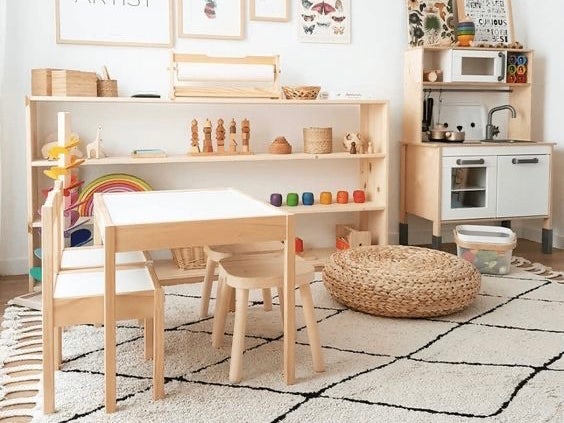
If you're looking to create a Montessori-inspired playroom for your little one, you may feel overwhelmed by the insanely aesthetic pictures you see on social media … or the price point of some Montessori toys! But no worries – we’ve got some great tips for designing your Montessori playroom without stressing about what you see on social media. Here’s how you can get started!
Offer Montessori-style activities and toys
Of course, a Montessori playroom should have Montessori-approved activities… but this is where many parents get hung up or discouraged. They may feel like their kids should only play with wooden puzzles or feel like they can’t implement Montessori unless they have the budget for expensive Montessori toys. The truth is plenty of Montessori-inspired activities can be recreated with items you already have in your home! And there are plenty of affordable, Montessori-style toys as well. These tips for doing Montessori on a Budget from Ashely Yeh can get you started without breaking the bank! (Plus, she offers the great reminder that Montessori is far more about respect for your child than it is about the stuff!)
Observe your child
We know, this tip doesn’t actually have anything to do with setting up a playroom, but observation is an essential part of the Montessori method! When your child plays independently, dedicate some time to watching them without interrupting or influencing their play. Take note of what captures their focus and of what challenges or problems they are interested in solving. Doing so will help you identify the types of toys and activities you should offer.
Use natural materials
Montessori emphasizes the use of high-quality, natural materials like wood, cotton, and wool. Whenever possible, choose these materials over plastics, but again, don’t stress over this.
Limit the number of toys
Montessori believed that too many toys could overwhelm a child and hinder their ability to focus and engage in purposeful play. By providing a limited number of toys, children are more likely to use them in a meaningful way, explore them in depth, and develop their creativity and imagination. So rather than filling the playroom with a ton of toys, try to keep it simple and rotate out toys as your child loses interest in them.
Encourage creativity
In most Montessori classrooms, kids can access art supplies any time they’d like (and they’ve been well-guided in how to clean up after themselves, so the messes are minimal!) You can recreate these art stations in your Montessori playroom by providing open-ended art supplies like modeling dough, paints, and other craft supplies.
Incorporate practical life skills
Montessori education emphasizes practical life skills, so consider adding things like a child-sized broom and dustpan, a watering can, and other child-sized tools to encourage your child's independence and responsibility.
Pro tip: Montessori families often add a wooden play kitchen to encourage practical life skills and imaginative play. Many take it a step further by using the play kitchen as a functional kitchen. This means adding real utensils, plates, cups, and even real food ingredients (like simple snacks children can prepare themselves) to the play kitchen. Of course, you know your child best, so only provide the tools and food you know they can handle safely.
Remember, your playroom doesn’t need to look Insta-worthy to be authentically Montessori. The most important thing is to create a space where your child feels and empowered to learn, focus, and play at their own pace!

